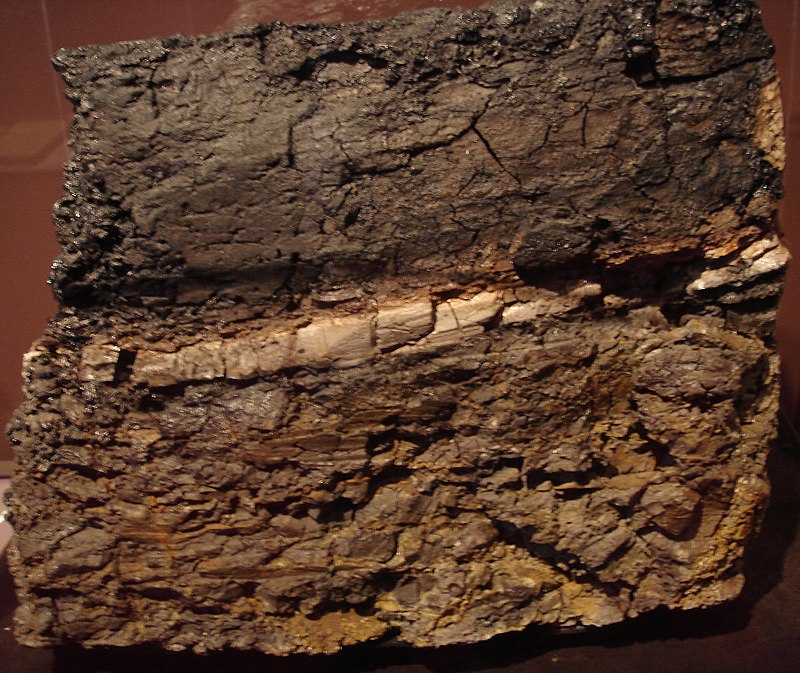
For many people, one of the most fascinating periods of Earth’s natural history is the Mesozoic Era, which spanned from roughly 252 million years ago to 66 million years ago. This period of time is often called the “Age of Dinosaurs,” and indeed these large reptiles were the dominant animals on Earth for well over 150 million years. This era came to a rather abrupt end at the end of the Cretaceous Period 66 million years ago, when the dinosaurs and a significant fraction – approximately three-fourths – of Earth’s other biological species disappeared within a (geologically) short period of time. This episode of “mass extinction” is generally referred to as the “K-T Event,” the “K” referring to the Cretaceous Period (from its name in German) and the “T” referring to the Tertiary Period at the beginning of the Cenozoic Era – within which we are now living – although the Tertiary Period is now formally called the Paleogene Period. (The K-T Event is thus more formally the “K-Pg Event.”)
Additional mass extinctions have taken place from time to time throughout Earth’s natural history. Indeed, the Mesozoic Era began with the largest one of all, at the end of the Permian Period 252 million years ago. During that particular mass extinction – the “Permian-Triassic” event – as many as 70% to 80% of all biological species, including over 90% of marine species, disappeared.
Although such mass extinctions spelled the end of many of Earth’s life forms, at the same time they created opportunities for other species to thrive and eventually become dominant. For example, while the K-T Event brought about the demise of the dinosaurs who had been dominant so long, among the survivors were small, shrew-like mammals. The “hole in nature,” as it were, created by the disappearance of the dinosaurs allowed these mammals to thrive and eventually become dominant; we are here as a direct result of that.
The specific cause, or causes, of the K-T mass extinction has long been a matter of much speculation and debate. Global climate change has often been considered at least one of the dominant causes, although what might have precipitated this has in turn engendered additional debate and speculation. A series of massive volcanic eruptions that produced the Deccan Flats region of India and covered that area with volcanic basalts and other igneous rocks is known to have been occurring at that time, and these would have released massive amounts of dust and greenhouse gases into the atmosphere; these eruptions were widely considered to have been at least partially responsible for creating the conditions that led to the K-T extinction.
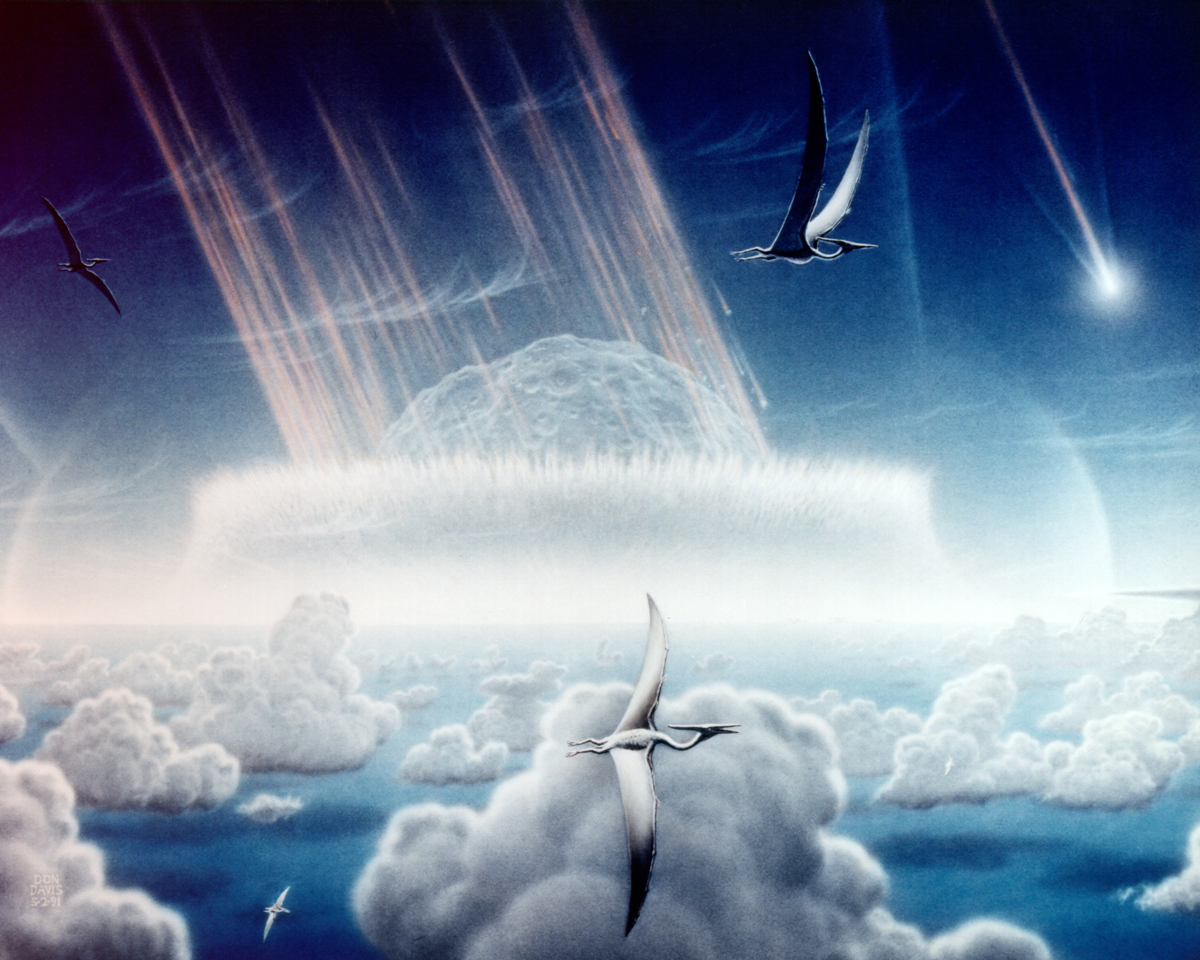
During the late 1970s the Nobel Prize-winning physicist Luis Alvarez and his geologist son Walter Alvarez found that sediments around the world that were deposited between those of the Cretaceous and Paleogene Periods are enriched with the metal iridium, sometimes by a factor of several hundred over its natural occurrence. Iridium is, in fact, a very rare metal on Earth’s surface, but is much more common in meteorites. From this, the Alvarezes concluded that Earth had been struck by a fairly large – 10 km or so – asteroid (or comet) just before the end of the Cretaceous Period, and that it was this event that in turn created the conditions that led to the K-T mass extinction. Their paper was published in June 1980 in the journal Science.
The Alvarezes’ hypothesis created quite a sensation in scientific circles, but as is true for most dramatic scientific ideas it was not especially widely accepted at first. Over the subsequent decade acceptance began to grow as more and more sediments from that time frame were analyzed and as the study of effects of meteorite impacts progressed. Meanwhile, at around this same time two geologists, Glen Penfield and Antonio Camargo, who were conducting survey work for the Mexican state-owned oil company Pemex, began detecting evidence of a large subterranean impact crater underneath the northern coast of the Yucatan peninsula near the village of Puerto Chicxulub. Detailed analyses of this feature over the next few years, conducted in part by American geologist Alan Hildebrand, determined that this crater, 150 km in diameter, dates from the exact same time as the K-T extinction event, and in 1991 Hildebrand and Penfield published their paper concluding that the impact that produced the Chicxulub crater was the event hypothesized by the Alvarezes that led to the K-T mass extinction – the “smoking gun,” in popular parlance.
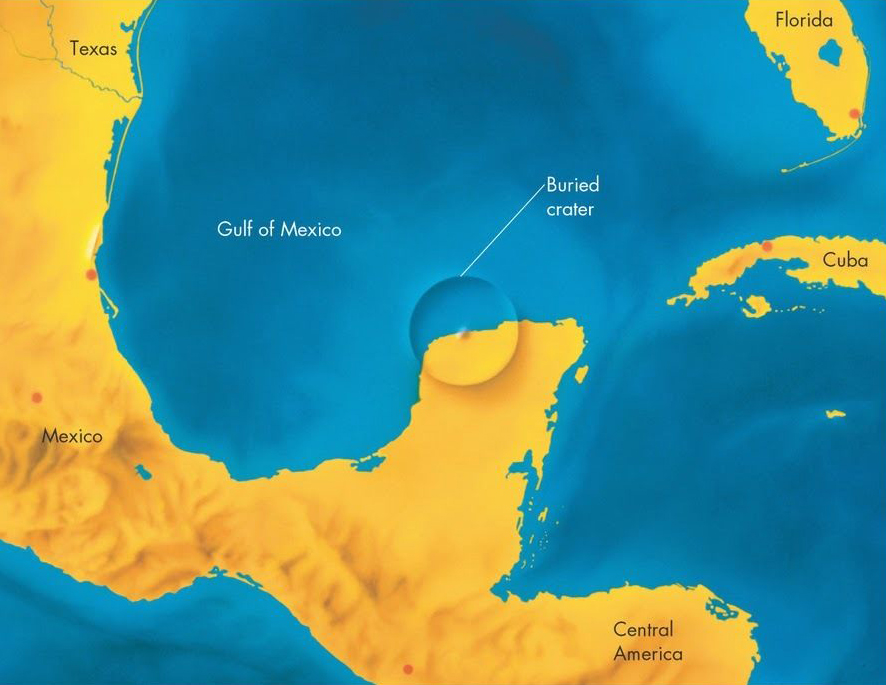
Subsequent study of the Chicxulub crater has continued to reinforce this conclusion, and today the idea that this impact event 66 million years ago created the conditions that led to the K-T extinction, including the demise of the dinosaurs, has gained wide acceptance. According to the general scenario, the impact would have released several hundred million megatons of energy, and would have thrown up large amounts of dust into the atmosphere – to be carried globally by atmospheric winds – as well as instigated large tsunamis. Furthermore, the heat generated by the impacting object’s passage through the atmosphere would have ignited forest fires in large areas surrounding the impact site; these in turn would have expelled large amounts of smoke into the atmosphere that also would have been carried globally. The net result would have been a global shrouding of the sun and widespread global cooling – phenomena sometimes incorporated under the phrase “nuclear winter.” This would have persisted for several years as various biological species up and down the food chain died, creating the mass extinction.
Just a year ago a provocative paper published by American geologist Robert DePalma describes large numbers of fossils of fish and other biological species at the Hell Creek Formation in North Dakota, that show evidence of these creatures having died on the very day of the Chicxulub impact. Tektites – described in a previous “Special Topics” presentation – created during the impact apparently rained down upon and were ingested by the creatures, and then a large mass of onrushing water – apparently created by a tsunami generated by the impact – buried them. Much research remains to be performed at this site, but if these conclusions are verified in coming years they can offer valuable insights into the goings-on during the midst of an extinction event.
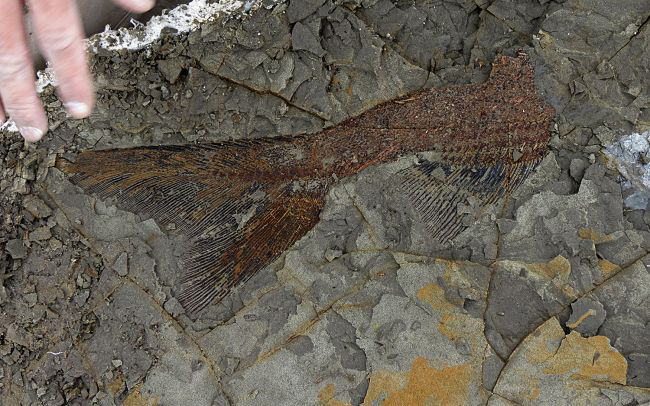
While acceptance of the idea that the Chicxulub impact led to the demise of the dinosaurs is quite widespread at this time, the idea that this one single event was responsible for the entirety of the K-T mass extinction is not universally accepted. There is evidence that other, smaller impacts may have occurred within the same general time frame and contributed to the various extinctions, and the contributing effects of the Deccan Traps eruptions are also a matter of debate. Since the Deccan Traps region is almost directly opposite the earth’s center from the Chicxulub crater it is conceivable that the impact heated the subterranean magma to such an extent that this contributed to the Deccan Traps eruptions; while these had started before the Chicxulub impact, this event might have greatly increased their strength and their output.
In any event, the realization that an impact event at the end of the Cretaceous Period is at least substantially responsible for the deaths of much of the life on Earth at that time has created a paradigm shift in our understanding of natural history. Prior to that, a “uniformitarian” worldview, i.e., natural history comprises a steady series of gradual changes, was the dominant viewpoint, as opposed to “catastrophism,” i.e., natural history is a series of catastrophic events. The incorporation of the Chicxulub impact and the resulting K-T mass extinction into our understanding of Earth’s natural history has shown that these two viewpoints are not mutually exclusive, and in fact catastrophic events like impacts are now recognized as being a regular part of a uniformitarian natural progression. This has been further reinforced in more recent years by events like the Shoemaker-Levy 9 impacts into Jupiter in 1994 – just three years after the identification of the Chixculub crater as being the impact site, and the subject of a future “Comet of the Week” presentation – as well as the increased discovery rate of Earth-approaching asteroids and comets and a better understanding of the role that impacts have played with other worlds in our solar system.
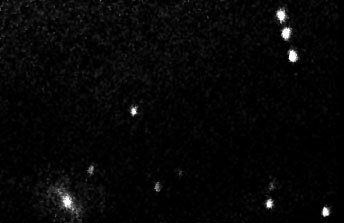
This increased understanding has in turn led to speculation that other extinction events in Earth’s natural history, for example, the one at the end of the Permian Period, may also have been due to impact events, and it is indeed entirely possible that this is true in at least some cases. During the 1980s, as the Alvarez hypothesis was gaining acceptance, some researchers claim to have identified an approximate 26-million-year periodicity in the occurrence of mass extinctions, and proposed that a distant, possibly sub-stellar, companion of the sun dubbed “Nemesis” would pass through the Oort Cloud at such intervals and send “comet showers” inward towards the inner solar system, thus leading to increased chances of impacts and resulting mass extinctions when they arrived. Other researchers have pointed out that the evidence for this periodicity in extinction events is quite weak, and in the meantime despite comprehensive sky surveys – including in the infrared, where any such object should be readily apparent – no “Nemesis” has been found, and this idea is currently not widely accepted. This notwithstanding, as covered in a previous “Special Topics” presentation passing stars do on occasion pass through the Oort Cloud, in turn sending potential “comet showers” inward and thereby creating increased risks of large impact events and potential mass extinctions.
There have been efforts over the years to find the source of the Chicxulub impactor. In 2007 some astronomers suggested that an asteroid associated with the main-belt asteroid (298) Baptistina might have been responsible. According to the scenario, approximately 160 million years ago a fairly large asteroid – perhaps 170 km across – was struck by another, smaller asteroid, with the result being the fragmentation of the larger object into several thousand smaller ones. The largest of these is Baptistina, and the others travel in roughly similar orbits and are collectively are called the “Baptistina family.” (Asteroid “families” are discussed in a future “Special Topics” presentation.) Over time, due to gravitational and other orbital influences, some of these smaller asteroids were perturbed into Earth-crossing orbits, and eventually one of these found its way to Earth 66 million years ago.

However, a detailed examination of Baptistina and other asteroids in its “family” carried out by the Wide-field Infrared Survey Explorer (WISE) spacecraft in 2010-11 shows that the asteroid collision event that produced the Baptistina “family” occurred close to 80 million years ago. Since it normally would take several tens of millions of years for asteroids in the main belt to get perturbed into Earth-crossing orbits, this does not leave enough time for one of the fragments from that collision to make its way to Earth. Whatever struck Earth, then, at the end of the Cretaceous Period would have had to have come from elsewhere.
The increased awareness that has come with our better understanding of the goings-on at the end of the Cretaceous Period and the knowledge that Earth has been repeatedly struck by asteroids and comets throughout its natural history, together with our increased knowledge of the objects still present in near-Earth space, has spawned the realization that, at some point in the future, Earth will be struck again. We would obviously not want the dinosaurs’ fate to happen to us, and thus the emphasis on survey programs and other impact-mitigation activities that are discussed throughout “Ice and Stone 2020.” If humanity is to bypass the fate of the dinosaurs, we need to be able to identify and deal with potentially threatening objects, and/or be able to expand into space.
More from Week 23:
This Week in History Comet of the Week Free PDF Download Glossary
Ice and Stone 2020 Home Page


